Since spring, the orchard appears to have been a haven for thistles. Sow thistle (Sonchus asper), and the occasional artichoke thistle (Cynara cardunculus) predominated in early spring, along with some wild mustard. They were removed, and now, as the weather has turned warm, the Bull Thistles (Cirsium vulgare) are springing up across the orchard hillside.
Cirsium vulgare, like the cudweeds, is a member of the Asteraceae family, and is classified as a moderately invasive plant in California by the California Invasive Plant Council (Cal-IPC). Native to Europe, Western Asia and North Africa, it has naturalized throughout much of the United States. As it invades native wild land, Cirsium vulgare displaces native species by competing for water, space, and nutrients.
These plants are usually biennial, with flowers emerging in the second year of growth between June and October.
I say usually biennial. One mistake we made in attempting to control these thistles this spring, was to cut them back before the plants had gained much size. Apparently though, if these thistles are cut down too early in the season, the plants re-sprout with significant vigor, and will bloom in the first season, rather than the second. This explains why, when we cleared the orchard last year, that these plants have already grown to over four feet in height and are starting to flower already. Ideally, these thistles should not be cut down until shortly before they bloom.
It’s critical to remove the cut plants however, as flower heads, even when cut, can still produce viable seed.
These plants, like our cudweeds, seem to favor sites that have been recently disturbed. These thistles also occasionally sprout up in random places on the property, even through the middle of established shrubs, but perhaps we can blame the gophers for that. Apparently, a small disturbance, even as small as a gopher mound, is enough to encourage Bull Thistles to sprout. More on our gopher troubles later.
Although an individual plant can produce thousands of seeds, Bull Thistles only reproduce from seed, and each plant only sets seed once before it dies. Theoretically, controlling these plants should be a far simpler task, than our invasive French Broom. These thistles aren’t particularly difficult to remove by hand, although the job is rather unpleasant, and not without pain. The leaves are heavily armored with lethal-looking spines, requiring the thickest pair(s) of gloves you can find.
These thorns have easily pierced through the thickest leather work gloves. To avoid excessive skewering we usually dig out the base of the plant, and handle the plants near the taproot where they’re somewhat easier to grasp without being run through.
It’s rather unfortunate this plant is so ill-mannered and invasive. The blooms are actually quite beautiful, and do produce abundant nectar, much to the delight of our bumble bees. Even the few plants currently starting to bloom have been enticing our native bees to sip from their blossoms.
However, its weedy thuggish nature negates its benefits, but to appease our bees, we do have alternatives. In place of Cirsium vulgare, we can plant an alternative thistle of the same genus that is actually native to this part of California, Cirsium occidentale, the Cobweb or Western thistle, which is also a preferred larval food source for the Mylitta Crescent butterflies that reside here (Phyciodes mylitta). It may sound strange, intentionally planting thistles, but we have areas around the periphery of the orchard that are too steep to plant any food plants, so why not plant something that we know will make the bees happy?

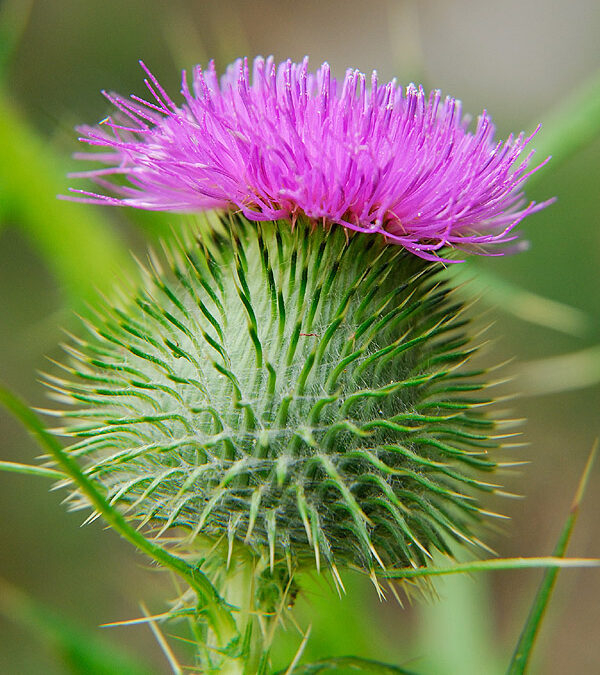
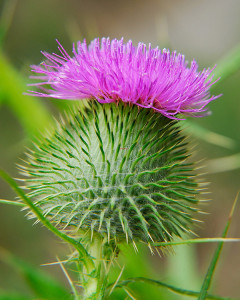
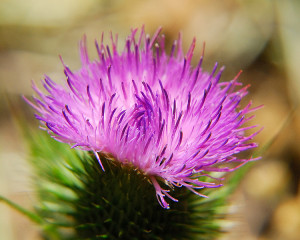
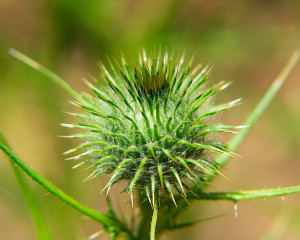
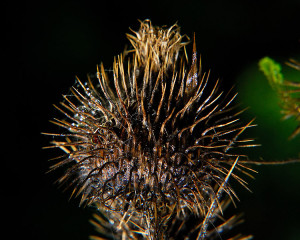

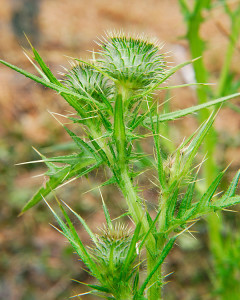
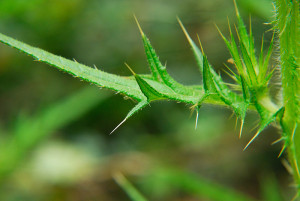
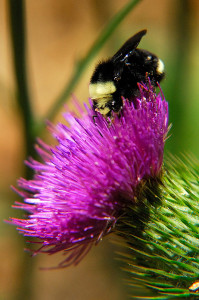







For once Clare you have a native flower that looks familar to me! We have these everywhere in flower just now………. it is the Flower of Scotland and the name of our unoffical national anthem.
When I first saw them in California, I was actually happy to see them, as I remembered seeing them in England as a child. They were familiar. I used to feel the same way about the broom here too. Unfortunately, they’re not native here, and grow a little too well in some areas. I still think the thistles are beautiful though, but the ‘responsible gardener’ in me feels it’s best to remove them. I do want to try growing its native cousin though, the Cobweb thistle. So long as I don’t have to garden around them, I love thistles.
I love thistle flowers and since the bees seem enjoy them too I’m not their worst enemy unless one bayonets me or is growing anywhere (basically in sight) my wife would give me grief over.
Well, if your wife lived here, she’d mandate their removal. We have so many at the moment, you can’t walk from one fruit tree to another in the orchard without bumping into one…and that hurts! 😛
I knew I wasn’t the only one that thought thistle had pretty blooms lol. They can be pretty nasty though! 🙂
I secretly like the look of them, but at someone else’s house.
I too find these blooms beautiful! It’s a shame when beautiful blooms are such thugs.
I confess to having a secret crush on this thistle, which I saw often in my home state of Georgia. I know it’s invasive, and holy cow! you surprised me by revealing that even cut flowers can produce viable seed, so now I know it’s even a bit more evil in its invasive tendencies than I’d realized. Still, they are so pretty… especially with the bees nestled down in there.
I’d definitely have difficulty ruthlessly ripping them out of the wildish areas of my property — even if I knew it was a best practice. I’m in awe of your determination to do the right thing for the land, Clare. 🙂
Hey, Clare! I have a love hate relationship with the thistle. The little flower is so pretty. I’ve been known not to pull it (as long as it was isolated) just to enjoy the little colorful puff on top. But, they are definitely a problem in the garden!
I so love visiting and learning, Clare. You are ‘the bestest’!
I occasionally see thistle coming up here and usually dig them up because of prickly they are. They do have a really pretty flower though. Will you show pictures of the native Thistle when they bloom? I’d love to see what they look like.
This reminds me of the conundrum with Fennel. The invasion of Fennel has allowed the Swallowtail butterflies to hatch multiple times throughout the year, but the plant has invaded many habitats, choking out the native larval food plants.